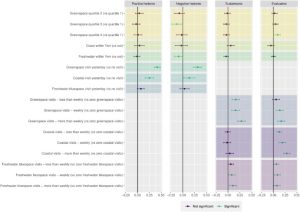What Types of Nature Exposure Are Associated With Hedonic, Eudaimonic and Evaluative Wellbeing? An 18-Country Study
Citation
McDougall, C. W., Elliott, L. R., White, M. P., Grellier, J., Bell, S., Bratman, G. N., … & Fleming, L. E. (2024). What types of nature exposure are associated with hedonic, eudaimonic and evaluative wellbeing? An 18-country study. Journal of Environmental Psychology, 102479. doi.org/10.1016/j.jenvp.2024.102479
While spending time in nature is known to make people feel happier and healthier, researchers still don’t fully understand how different kinds of nature experiences relate to different aspects of well-being or whether these patterns are the same around the world.
In this study, researchers looked at data from 18 countries to explore how time spent in different types of natural environments—such as parks and forests (green spaces), beaches (coastal blue spaces), and rivers or lakes (freshwater blue spaces)—relates to people’s well-being.
They examined three types of wellbeing:
- Hedonic well-being (emotions of pleasure)
- Eudaimonic well-being (how meaningful/worthwhile individuals think their behaviors/activities are)
- Evaluative well-being (how people rate their lives overall)
The study found that simply living near nature was not strongly linked to well-being. However, people who had visited green or coastal areas the day before reported better hedonic well-being. Frequently visiting green, coastal, and freshwater spaces were all associated with greater evaluative well-being. Greater eudaimonic well-being was only associated with frequent visits to green and freshwater spaces.
The patterns were not identical across countries. Overall, the results show that different kinds of nature experiences may support different types of well-being. Understanding these differences can help communities and policymakers design natural spaces that best support people’s health and well-being.
Abstract

Although spending time in nature can improve subjective wellbeing (SWB), little is known about how different types of nature exposure are associated with different dimensions of SWB or the consistency of associations across national/cultural contexts. Using data from 18 countries, associations between green, coastal and freshwater blue space exposures (including residential availability, visits ‘yesterday’ and visits in the previous four weeks) and hedonic, eudaimonic, and evaluative wellbeing were estimated. Overall, residential nature availability showed little association with any wellbeing outcome, whereas visiting green and coastal locations ‘yesterday’ was associated with better hedonic wellbeing. Although frequently visiting green, coastal and freshwater spaces were all associated with greater evaluative wellbeing, greater eudaimonic wellbeing was only associated with frequent visits to green and freshwater spaces. Variations existed across countries. Results suggest that different types of nature exposure vary in their association with different dimensions of SWB. Understanding these differences may help us maximise the potential of natural environments as SWB-promoting resources.